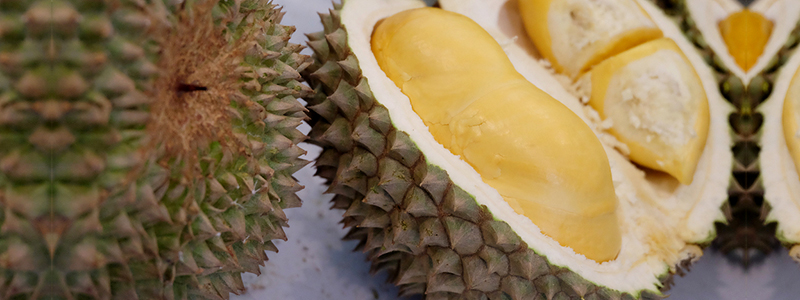Species
The scientists behind durian say there are about 30 different species of durian. Of these, only ten produce the edible fruit we all crave. Geographically the durian farming is restricted to Southeast Asia, within which the most common species is Durio zibethinus. In Malaysia, it is often referred to as a kampung [village], durian. These kampung durians can be found everywhere. They are tasty rather than delicious, and as such they are more of a staple than a sought after indulgence. Understandably their price point is at the lower end of the durian spectrum.
Across the last few decades, farmers have bred hundreds of hybrids. Some believe that capitalism is in play here as farmers seek to maximise their profits. But if you understand the passion behind durian cultivation, you can see that for many farmers, experimenting with varieties, cultivars and grafting has become an almost religious pursuit to grow the best durian in the world. One of these hybrid durian varieties, which I will discuss more at the end of the post, is the so-called civet cat durian, or Musang [musang = fox/civet] King durian. Civet cats like to eat durian, but it is not clear whether the name comes from the cats’ fondness for durian, or the cats rancid smell imitates the durian odour.

Shape
Malaysia is known as the home of the durian, but there are also varieties native to Vietnam, Philippines, Cambodia, Borneo, and Indonesia. Regardless of where you get your durian from, they are usually vibrant green and often turn brown as they ripen. They are the size of a watermelon, but are oddly shaped and covered with very spiny thorns (the word for thorns in the Malay language is duri). Many Europeans joke that they would have made a very good weapon in the Middle Ages!
To avoid injury, one must be careful when handling them. Many tourists in Asia are warned not to sit under coconut trees because their falling coconuts kill people every year. The durian tree is not as tall, but it is easy to imagine that one of those spiky fruits landing on your head would do some serious damage. For this reason, I was told that anyone working on durian plantations must wear hard hats. (Although the Asian safety mentality makes it difficult to get farmers to switch from barefoot boots to safety shoes, let alone hard hats.)

Fruit Pulp
The flesh inside the skin is generally pale cream or yellow. Some species, such as the red prawn, have red flesh. These are from the Durio graveolens species where the flesh can be red, orange or yellow. The husk contains five segments of flesh. Many consider durians to be a close relative of jackfruit, which has a very similar appearance but smaller, flat spines and is easy to handle. Surprisingly, jackfruit and durian are not related. Genome tests have shown that the plant most closely related to the durian is cotton.

Musang King
The most popular durian variety is the Musang King. It dates back to the 1980’s when a gentleman from Pahang, Tan Lai Fook, found a tree in Gua Musang [cat cave] in Kelantan (a state in northern Malaysia). He cut off a branch and grafted it on to a tree in Raub, Pahang (a central state of Malaysia). The flesh of the Musang King variety is strong deep yellow, and it is now the most sought-after durian in the world. Hence the moniker, Musang King, ‘The King of Durian’. Incidentally, the Chinese refer to Musang King as the Hermès of durian!
The Next King of Durian
Some claim the Malaysian Black Thorn durian is even better than the Musang King. The flesh is creamier and has a beautiful deep orange colour with a dense, soft texture. It is a very new hybrid and as such there are very limited number of trees. The price per kg of the Black Thorn is even more expensive than the Musang King. Despite its heavy price, it has become so popular amongst Malaysians that very little fruit makes it out of the country.

I have tried the black thorn many times. Very expensive, because it is very very yummy. It will be the new King of Durian
Comments are closed.